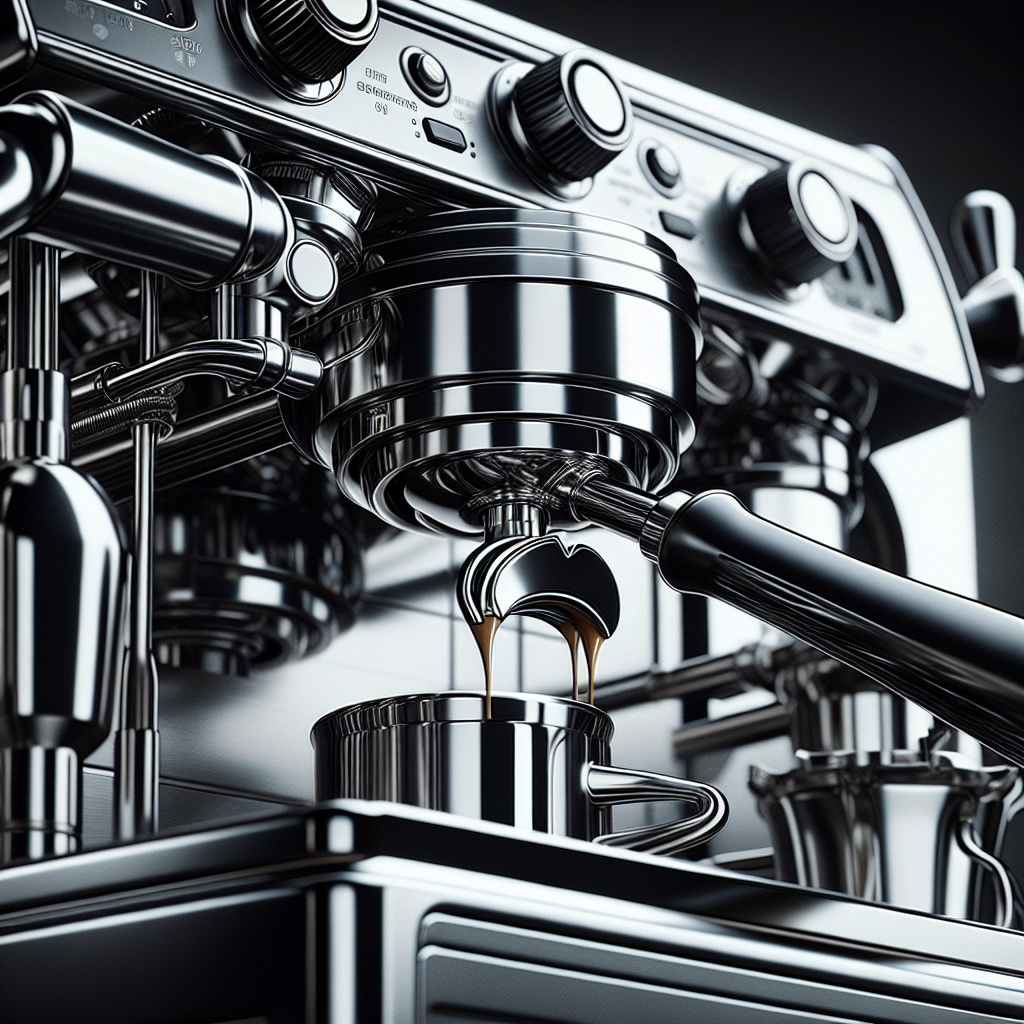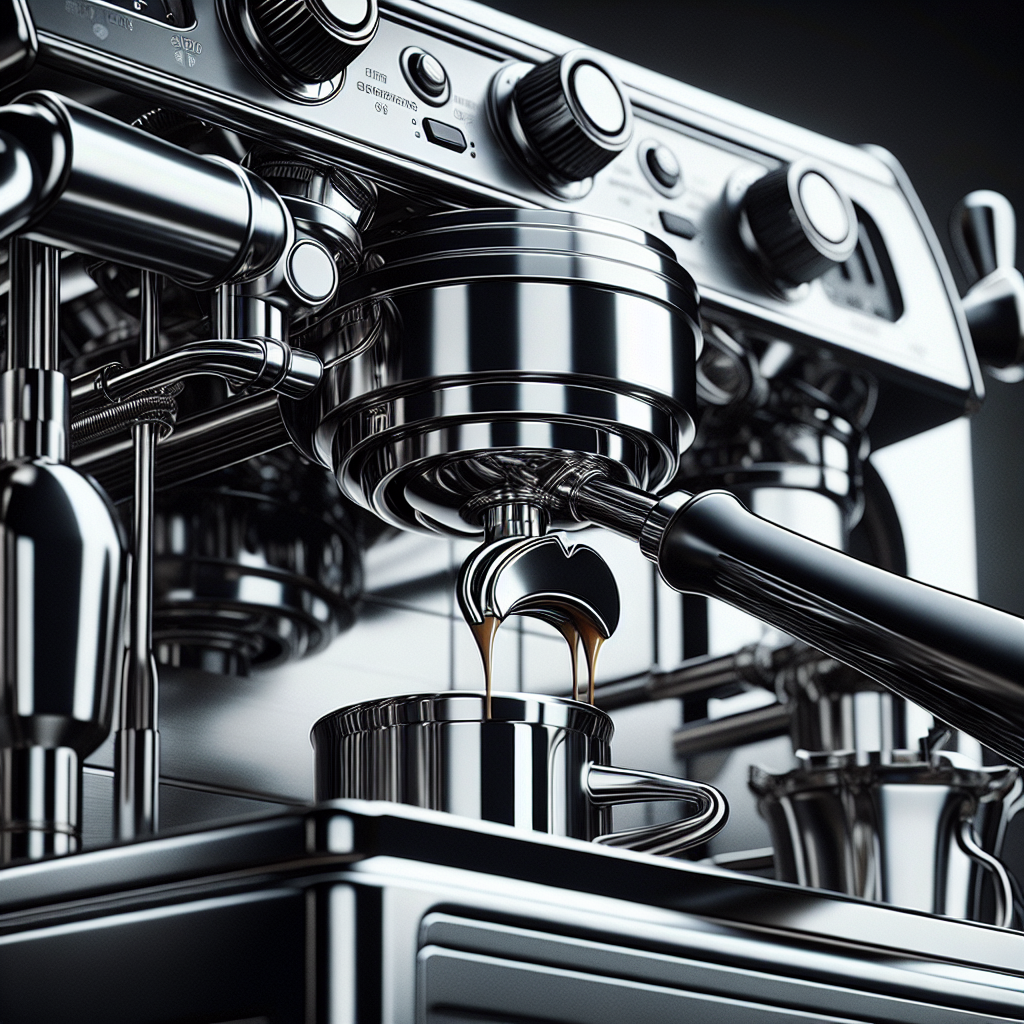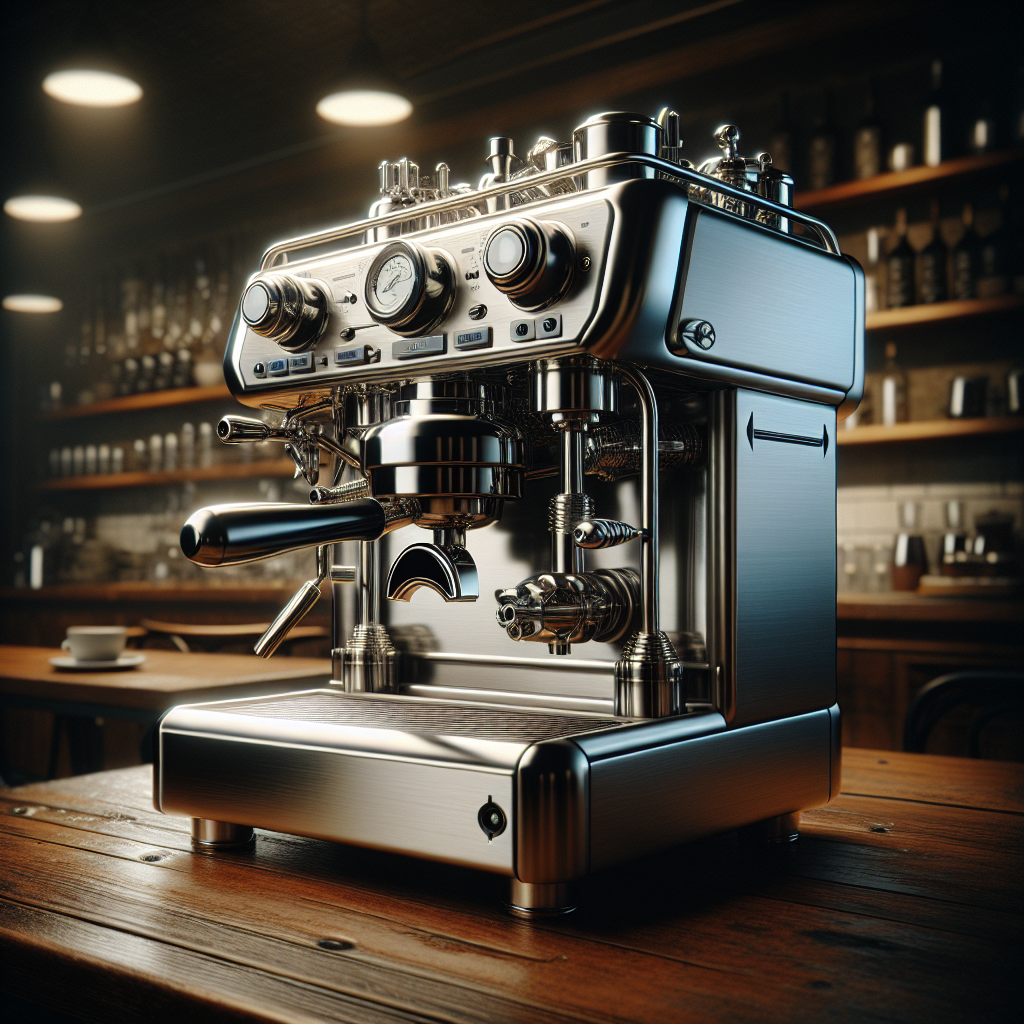
In this article, you will gain a comprehensive understanding of the various types of stainless steel that are commonly used in espresso machines. From the sleek and durable designs of 304 and 316 stainless steel to the corrosion-resistant properties of 430 stainless steel, we will explore the characteristics that make each type unique. By delving into the world of stainless steel, you will be equipped with valuable knowledge when it comes to choosing the right espresso machine for you.
Stainless Steel Overview
Stainless steel is a versatile and widely-used material in the manufacturing of espresso machines. It is valued for its durability, corrosion resistance, and aesthetics. In this article, we will explore the various types of stainless steel, their properties, and their applications in espresso machines.
Definition of Stainless Steel
Stainless steel is an alloy of iron that contains a minimum of 10.5% chromium. The addition of chromium to the steel creates a protective layer of chromium oxide, which gives stainless steel its corrosion resistance. This protective layer helps prevent rust and staining, making stainless steel an ideal choice for espresso machines that are constantly exposed to water and steam.
Importance of Stainless Steel in Espresso Machines
Stainless steel plays a crucial role in the functionality and longevity of espresso machines. The high temperatures, moisture, and pressure within an espresso machine can be corrosive to many materials. However, stainless steel is highly resistant to corrosion, ensuring that the internal components of the machine will not degrade over time. In addition, stainless steel is easy to clean, which is important for maintaining hygiene in a coffee shop or home kitchen setting.

Advantages of Stainless Steel
There are several advantages to using stainless steel in espresso machines. Firstly, its corrosion resistance ensures that the machine will have a longer lifespan and will require less maintenance. Stainless steel is also lightweight, making it easier to transport or move the espresso machine if needed. Furthermore, stainless steel is heat resistant, allowing it to withstand the high temperatures associated with brewing espresso. Lastly, stainless steel is aesthetically pleasing, giving espresso machines a sleek and modern look that is often associated with high-quality coffee equipment.
Common Types of Stainless Steel
There are several common types of stainless steel, each with its own unique properties and characteristics. Understanding these different types can help in choosing the right stainless steel for an espresso machine.
Austenitic Stainless Steel
Austenitic stainless steel is the most common type of stainless steel used in espresso machines. It is characterized by its high levels of chromium and nickel, which give it excellent corrosion resistance and ductility. Austenitic stainless steel is non-magnetic and has a face-centered cubic crystal structure. This type of stainless steel is widely used for its versatility and can be easily formed and welded.
Martensitic Stainless Steel
Martensitic stainless steel is known for its high strength and hardness. It contains higher levels of carbon and lower levels of nickel compared to austenitic stainless steel. Martensitic stainless steel has a body-centered cubic crystal structure and can be hardened through heat treatment. This type of stainless steel is commonly used in the manufacturing of espresso machine components that require high strength and resistance to wear.
Ferritic Stainless Steel
Ferritic stainless steel is characterized by its high levels of chromium and lower levels of carbon compared to other types of stainless steel. It has a body-centered cubic crystal structure and is magnetic. Ferritic stainless steel offers good corrosion resistance and is often used in applications where formability and weldability are important. In espresso machines, ferritic stainless steel is commonly used for its thermal and mechanical stability.
Duplex Stainless Steel
Duplex stainless steel is a combination of austenitic and ferritic stainless steels. It offers a balance of properties from both types, including high strength and corrosion resistance. Duplex stainless steel has a two-phase microstructure, consisting of both austenite and ferrite. This type of stainless steel is commonly used in espresso machine boilers and other components that require excellent stress corrosion cracking resistance.
Precipitation Hardening Stainless Steel
Precipitation hardening stainless steel, also known as PH stainless steel, is characterized by its high strength and corrosion resistance. It can be hardened through a precipitation hardening process, which involves heat treatment followed by aging. Precipitation hardening stainless steel is used in espresso machines for components that are subject to high stress and require superior mechanical properties.
Properties and Characteristics
Stainless steel possesses several properties and characteristics that make it an ideal material for espresso machines.
Corrosion Resistance
One of the most important properties of stainless steel is its corrosion resistance. The presence of chromium in the alloy creates a protective layer that prevents the material from oxidizing or rusting. This is particularly important in espresso machines, as they are exposed to water, steam, and various acidic substances during the brewing process. Stainless steel ensures that the internal components of the machine remain intact and free from corrosion, contributing to the longevity and performance of the espresso machine.
Strength and Durability
Stainless steel is known for its strength and durability. It can withstand high pressure and temperature fluctuations without deforming or breaking. This is essential in espresso machines, where water and steam are continuously applied to extract the flavors from coffee grounds. The strong and durable nature of stainless steel ensures that the machine can handle the rigors of daily use and maintain its structural integrity over time.
Heat Resistance
Espresso machines generate high temperatures during the brewing process, and stainless steel excels in heat resistance. Stainless steel can withstand these elevated temperatures without warping or undergoing any structural changes. This is crucial for espresso machines, as the heat generated is necessary to brew the perfect cup of espresso. Stainless steel components ensure that the machine can consistently achieve and maintain the desired temperature for optimal coffee extraction.
Machinability
Stainless steel is also highly machinable, meaning it can be easily shaped and formed into complex parts and components. This property allows manufacturers to create intricate designs and precise tolerances in espresso machine construction. The machinability of stainless steel ensures that the internal mechanisms of the machine can be fabricated with precision, contributing to the overall performance and functionality of the espresso machine.
Weldability
Weldability is another important characteristic of stainless steel. It can be easily welded, allowing different parts of an espresso machine to be securely attached to one another. The ability to weld stainless steel eliminates the need for additional fasteners or connectors, resulting in a stronger and more seamless espresso machine design. Weldability also allows for easier repairs or modifications to the machine if needed, ensuring its longevity and versatility.

Austenitic Stainless Steel
Composition
Austenitic stainless steel is primarily composed of iron, chromium, and nickel. The chromium content is typically between 16% and 26%, while the nickel content is between 6% and 22%. This composition gives austenitic stainless steel its excellent corrosion resistance and high ductility.
Grades and Commonly Used Alloys
There are numerous grades and alloys of austenitic stainless steel, with each offering slightly different properties and characteristics. Some commonly used grades in espresso machine manufacturing include:
-
304: This grade is the most commonly used austenitic stainless steel in espresso machines. It offers good corrosion resistance, high strength, and excellent formability.
-
316: Stainless steel grade 316 is often used in espresso machines for its superior corrosion resistance, especially in environments with high chloride concentrations. It is also resistant to pitting and crevice corrosion, making it suitable for commercial espresso machines.
Applications in Espresso Machines
Austenitic stainless steel finds numerous applications in espresso machines. It is commonly used for the boiler, brewing chamber, portafilter, and other internal components that come into contact with water and coffee grounds. The corrosion resistance and formability of austenitic stainless steel make it an excellent choice for these critical components, ensuring the machine’s durability and performance.
Martensitic Stainless Steel
Composition
Martensitic stainless steel contains higher levels of carbon and lower levels of nickel compared to austenitic stainless steel. The carbon content is typically between 0.08% and 1.2%, while the nickel content is less than 14%. The higher carbon content gives martensitic stainless steel its hardness and increased tensile strength.
Grades and Commonly Used Alloys
The most common grades of martensitic stainless steel used in espresso machines include:
-
410: This grade is widely used for its high strength, hardness, and corrosion resistance. It is often used for espresso machine components such as grinder burrs, pump shafts, and other parts that require wear resistance.
-
420: Stainless steel grade 420 offers high strength, hardness, and wear resistance. It is commonly used for manufacturing espresso machine blades, including those in grinders and pumps.
Applications in Espresso Machines
Martensitic stainless steel is typically utilized in espresso machine components that require high strength and wear resistance. These components include grinder burrs, pump shafts, and blades. The hardness and toughness of martensitic stainless steel ensure that these critical parts can withstand the high pressures and forces associated with grinding coffee beans and pumping water.
Ferritic Stainless Steel
Composition
Ferritic stainless steel is characterized by its high chromium content, typically between 11% and 30%. It also has lower carbon levels compared to other types of stainless steel, usually less than 0.2%. The high chromium content provides ferritic stainless steel with good corrosion resistance.
Grades and Commonly Used Alloys
Common grades and alloys of ferritic stainless steel used in espresso machines include:
- 430: Stainless steel grade 430 is commonly used for its good formability and resistance to oxidation. It is often used for espresso machine components such as body panels and trim.
Applications in Espresso Machines
Ferritic stainless steel is mainly utilized in cosmetic applications in espresso machines due to its excellent formability and resistance to oxidation. It is commonly used for body panels, trims, and other non-structural parts, enhancing the overall aesthetics and durability of the espresso machine.
Duplex Stainless Steel
Composition
Duplex stainless steel is a combination of austenitic and ferritic stainless steels, with typical composition ranges being between 18% and 28% chromium and 4% to 7% nickel. This two-phase microstructure provides duplex stainless steel with a unique combination of properties, including high strength, excellent corrosion resistance, and good weldability.
Grades and Commonly Used Alloys
The most commonly used grade of duplex stainless steel in espresso machines is:
- 2205: Stainless steel grade 2205 offers superior corrosion resistance, high tensile strength, and good weldability. It is commonly used in espresso machine boilers, heat exchangers, and other components that require both strength and resistance to corrosion.
Applications in Espresso Machines
Duplex stainless steel is often used in espresso machine boilers and other components that are exposed to high temperatures and corrosive environments. The combination of strength and corrosion resistance makes duplex stainless steel an ideal choice for these critical parts, ensuring the longevity and performance of the espresso machine.
Precipitation Hardening Stainless Steel
Composition
Precipitation hardening stainless steel contains various alloying elements, including chromium, nickel, and copper. The addition of these elements allows for the precipitation of fine particles, which contribute to the material’s hardness and strength. The specific composition of precipitation hardening stainless steel can vary depending on the desired properties.
Grades and Commonly Used Alloys
The most commonly used grade of precipitation hardening stainless steel in espresso machines is:
- 17-4: Stainless steel grade 17-4 offers high strength, excellent corrosion resistance, and good heat resistance. It is often used for critical components in espresso machines that require superior mechanical properties, such as pump drives and steam wands.
Applications in Espresso Machines
Precipitation hardening stainless steel is commonly used for critical components in espresso machines that are subject to high stresses and require superior mechanical properties. These components include pump drives, steam wands, and other parts that need to withstand intense pressure and regular use.
Factors to Consider when Choosing Stainless Steel for Espresso Machines
When choosing the right stainless steel for an espresso machine, there are several factors to consider:
Cost
The cost of stainless steel can vary depending on the specific grade and alloy. Higher-grade stainless steels, such as those with higher levels of nickel, can be more expensive. It is important to balance cost considerations with the desired properties and performance requirements of the espresso machine.
Corrosion Resistance
Espresso machines are subjected to water, steam, and various acids during the brewing process. It is crucial to select a stainless steel grade that offers excellent corrosion resistance to ensure the longevity and performance of the machine. Consider the type of brewing environment, water quality, and the specific acids and cleaning agents that will be used with the espresso machine.
Food Safety Regulations
Espresso machines used in commercial settings must comply with strict food safety regulations. It is important to choose stainless steel grades that meet these regulations and are safe for contact with food and beverages. Look for stainless steel that is certified to meet international standards for food safety, such as NSF or FDA approvals.
Conclusion
Choosing the right stainless steel for espresso machines is essential for their longevity, performance, and overall quality of espresso. Austenitic stainless steel is commonly used for its corrosion resistance and formability, while martensitic stainless steel offers high strength and wear resistance. Ferritic stainless steel is mainly used for cosmetic applications, and duplex stainless steel provides a combination of strength and corrosion resistance. Precipitation hardening stainless steel is employed for critical components that require superior mechanical properties. Consider factors such as cost, corrosion resistance, and food safety regulations when selecting stainless steel for espresso machines. Stainless steel plays a vital role in the espresso brewing process, ensuring durability, hygiene, and an enjoyable coffee experience.